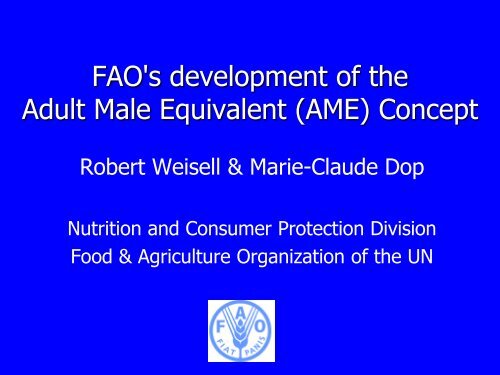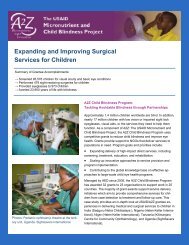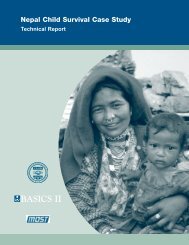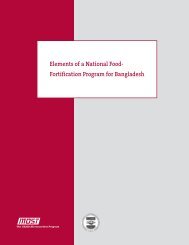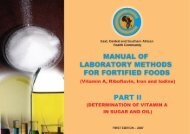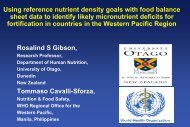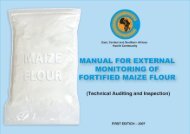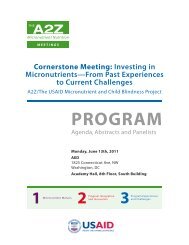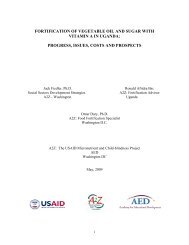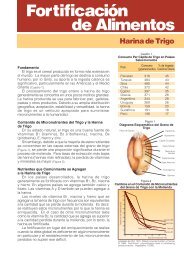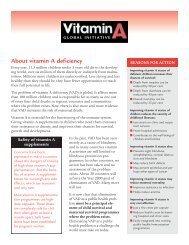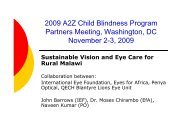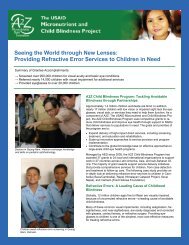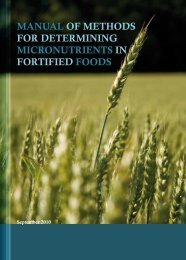FAO's development of the Adult Male Equivalent (AME) Concept
FAO's development of the Adult Male Equivalent (AME) Concept
FAO's development of the Adult Male Equivalent (AME) Concept
You also want an ePaper? Increase the reach of your titles
YUMPU automatically turns print PDFs into web optimized ePapers that Google loves.
<strong>FAO's</strong> <strong>development</strong> <strong>of</strong> <strong>the</strong><br />
<strong>Adult</strong> <strong>Male</strong> <strong>Equivalent</strong> (<strong>AME</strong>) <strong>Concept</strong><br />
Robert Weisell & Marie-Claude Dop<br />
Nutrition and Consumer Protection Division<br />
Food & Agriculture Organization <strong>of</strong> <strong>the</strong> UN
Definition <strong>of</strong><br />
<strong>Adult</strong> <strong>Male</strong> <strong>Equivalent</strong> (<strong>AME</strong>)<br />
The energy requirement <strong>of</strong> a household<br />
or ano<strong>the</strong>r food consumption unit<br />
expressed as a multiple <strong>of</strong> an adult male’s<br />
energy requirement.
Questions or Issued addressed<br />
Why is <strong>the</strong> <strong>AME</strong> advocated ?<br />
• To improve <strong>the</strong> analysis <strong>of</strong> HHFC&E<br />
surveys;
Questions or Issued addressed<br />
Why not just use per capita<br />
consumption?<br />
• HH members consume food in an attempt<br />
to meet <strong>the</strong>ir energy requirements which<br />
is largely dependent on body size and<br />
physical activity;<br />
• However, HH members vary in body size<br />
and level <strong>of</strong> physical expenditure.
Issues addressed<br />
• Calculation <strong>of</strong> <strong>AME</strong>;<br />
• Examine <strong>the</strong> minimum type or level <strong>of</strong><br />
data or information to determine <strong>the</strong><br />
<strong>AME</strong>.
Review <strong>of</strong> Energy Requirements:<br />
most recent FAO/WHO Joint Expert<br />
Consultations<br />
• 1971 Expert Consultation (1973 Report)<br />
• 1981 Expert Consultation (1985 Report)<br />
• 2001 Expert Consultation (2004 Report)
• 1973 Report:<br />
Principle <strong>Concept</strong>s<br />
– intake approach (a circular argument)<br />
– reference man and reference woman<br />
• 1985 Report:<br />
– Food intake => requirements for children
Principle <strong>Concept</strong>s<br />
2004 Report:<br />
– requirements based on energy expenditure;<br />
– socially desirable activities but considering<br />
varying levels <strong>of</strong> habitual physical activity;<br />
– exercise for cardiovascular well-being and<br />
muscular fitness;<br />
– more sophisticated calculation <strong>of</strong> energy<br />
needs during pregnancy and lactation.
2004 Report Factorial method<br />
• based on Total Energy Expenditure (TEE)<br />
• <strong>Adult</strong>s (>18 yr) Two major components <strong>of</strong> TEE:<br />
basal metabolic rate (BMR)<br />
physical activity<br />
• based on <strong>the</strong> duration <strong>of</strong> <strong>the</strong> different daily<br />
activities and related energy expenditure values.<br />
• use <strong>of</strong> <strong>the</strong> integrated energy index (IEI)<br />
energy expenditure <strong>of</strong> an activity with pauses and<br />
expressed as a multiple BMR; = to PAL value
Physical Activity Level (PAL)<br />
Total Energy Expenditure (TEE)<br />
When expressed as a multiple <strong>of</strong> BMR over<br />
24 hours = PAL<br />
Thus BMR X PAL = TEE<br />
1,600 kcal X 1.75 = 2,800 kcal
Development and calculation<br />
<strong>of</strong> <strong>the</strong> <strong>Adult</strong> <strong>Male</strong> <strong>Equivalent</strong>
Surveys using <strong>the</strong> <strong>AME</strong> (1)<br />
Madagascar – 1962, national rural, 5000 HH<br />
Brazil – 1970-75, nationwide, 55,000 families<br />
(IBGE - Instituto Brasileiro de Geografia e Estadïstica)<br />
Peru - late 1970s
Surveys using <strong>the</strong> <strong>AME</strong> (2)<br />
Tunisia – 1974-75, national HH budget and<br />
food consumption, 2,510 HHs<br />
Côte d’Ivoire – 1979, national food consump<br />
and expend, 720 rural & 1440 urban HHs<br />
Cape Verde – 2001-2002, national FC & HH<br />
expenditure, 4550 HHs
The reason for FAO conducting<br />
surveys<br />
• In <strong>the</strong> 1960’s FAO conducted <strong>the</strong><br />
“Indicative World Plan”;<br />
• Paucity <strong>of</strong> data on HH food consumption;<br />
• FAO advocated suggested appending food<br />
consumption data collection to <strong>the</strong><br />
household expenditure and budget surveys.
Two critical issues in calculating HH<br />
requirement<br />
1. Attendance at meals (including guests),<br />
number <strong>of</strong> meals and where meals were<br />
consumed if not at home.<br />
2. Determination <strong>of</strong> each participant’s<br />
energy requirement and <strong>the</strong>n weighting it<br />
compared to a typical adult male.
Problems/issues:<br />
To recap:<br />
• Absences due to that person not eating or<br />
eating outside;<br />
• Guests at <strong>the</strong> meal;<br />
• Differences in <strong>the</strong> meal patterns among<br />
members: number and which meals);<br />
• For any one person <strong>the</strong> difference in <strong>the</strong><br />
meal pattern from week to week.
Example <strong>of</strong> a 4 HH members + a guest<br />
• HH Member Sex Age Ref Wgt/Hgt<br />
• Head HH <strong>Male</strong> 45 64<br />
• Spouse Female 37 55<br />
• Daughter Female 12 44<br />
• Son <strong>Male</strong> 3 16<br />
• <strong>Adult</strong> Guest <strong>Male</strong> Unknown 64
Effect <strong>of</strong> meal attendance on HH Req.<br />
Day 1<br />
Cons Unit<br />
Members Breakfast Lunch Snack Dinner wgt <strong>of</strong><br />
at Meal 0.16 0.43 0.11 0.30 meal attd<br />
Head HH 0.16 0.11 0.30 0.57<br />
Spouse 0.16 0.43 0.30 0.89<br />
Daughter 0.16 0.43 0.11 0.30 1.00<br />
Son 0.16 0.43 0.11 0.30 1.00<br />
Guest 0.30 0.30<br />
Total CU* 3.76<br />
* number <strong>of</strong> CUs is used to express intake per capita
Effect <strong>of</strong> meal attendance and <strong>AME</strong><br />
on daily energy requirement<br />
Day 1 <strong>AME</strong> Consumer <strong>AME</strong> Daily Req<br />
Members Units Wgt. by X meal<br />
at Meal meal attd. attend.<br />
Head HH 1.000 0.57 0.57 1,604<br />
Spouse 0.806 0.89 0.72 2,018<br />
Daughter 0.810 1.00 0.81 2,278<br />
Son 0.444 1.00 0.44 1,249<br />
Guest 1.000 0.30 0.30 844<br />
Total 3.76 2.84 7,992<br />
2,126 kcal 2,813 kcal
intake from hypo HH and in Cape<br />
Verde survey<br />
Per cap<br />
Per <strong>AME</strong><br />
Hypo<strong>the</strong>tical<br />
Family<br />
Mean - Cape<br />
Verde Survey<br />
2126 2813<br />
1918 2619


